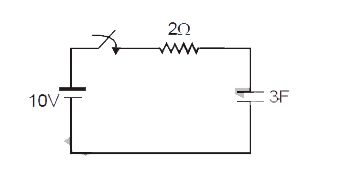The following two questions refer to the circuit shown. Assume that the capacitors are initially uncharged.

At time t = 0, the switch S in the circuit is closed. At that instant, what is the equivalent resistance of the circuit?
9.00
1.20
1.80
0.92
The correct Answer is:D
Initially capacitors act as conducting wire. So initially all the three resistor will be in parallel.
After long time, resistors will be in series,
Req=2+3+4=9Ω
I=249=83A
Potential difference 3μF= potential difference across (3Ω+4Ω)
⇒V3μF=(3+4)I=563v
q=CV3μF=3×563=56μC
Topper's Solved these Questions
- BOOK - CENGAGE PHYSICSCHAPTER - ELECTRIC CURRENT AND CIRCUITEXERCISE - Interger8videos
ELECTRIC CURRENT AND CIRCUIT
- BOOK - CENGAGE PHYSICSCHAPTER - ELECTRIC CURRENT AND CIRCUITEXERCISE - Multiple Correct16videos
ELECTRIC CURRENT AND CIRCUIT
- BOOK - CENGAGE PHYSICSCHAPTER - ELECTRIC CURRENT & CIRCUITSEXERCISE - Kirchhoff s law and simple circuits15videos
ELECTRIC CURRENT & CIRCUITS
- BOOK - CENGAGE PHYSICSCHAPTER - ELECTRIC FLUX AND GAUSS LAWEXERCISE - MCQ s38videos
ELECTRIC FLUX AND GAUSS LAW
Similar Questions
Knowledge Check
- Question 1 - Select One or More
In the circuit shown key is closed at t=0 with capacitor initially uncharged.
 ARate of increase of capacitors energy, just after the switch is closed is E2RBMaximum power supplied by the cell is E2RCAt t=RCIn2, capacitor is charged up to half of the energy stored by it in steady stateDAt t=RCIn2, potential difference across capacitor is same that across resistor.
ARate of increase of capacitors energy, just after the switch is closed is E2RBMaximum power supplied by the cell is E2RCAt t=RCIn2, capacitor is charged up to half of the energy stored by it in steady stateDAt t=RCIn2, potential difference across capacitor is same that across resistor. - Question 2 - Select One
The following two questions refer to the circuit shown. Assume that the capacitors are initially uncharged.

After the switch has been closed for a long time, how much charge is on the positive plate of the 3μF capacitor?A24μCB32μCC56μCD72μC - Question 3 - Select One

In the circuit shown, all the capacitors are initially uncharged. The current through the battery just after closing the switch 'S' isA2AB4AC5AD10A
Find out current in the circuit and charge on capacitor which is initially uncharged in the following situations

Just after the switch is closedView SolutionIn the circuit shown in figure, the capacitors are initially uncharged. The current through resistor PQ just after closing the switch is
 View Solution
View SolutionIn given circuit capacitorinitially uncharged.Now at t = 0 switch S is closed then current given by source at any time t is
 View Solution
View SolutionIn the circuit shown, the capacitor is initially uncharged. The switch S is closed at t = 0. Time after which voltage across capacitor and resistor are equal is:
 View Solution
View SolutionIn the circuit shown in the figure, the capacitor C is charged to a potential Vo. The heat generated in the circuit when the switch S is closed, is
View Solution



